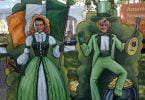
by Joe Bollig
Who invented the new evangelization?
Some would say Saint Pope John Paul II is the father of the new evangelization.
He first used the term on May 9, 1983, in an address to Latin American bishops. He developed the idea further in his Dec. 7, 1990, encyclical “Redemptoris misso” (“The Mission of the Redeemer”).
Some would point a little further back, to Saint Pope Paul VI.
He wrote in his Dec. 8, 1975, apostolic exhortation “Evangelii nuntiandi” (Evangelization in the modern world) that, “Evangelizing is in fact the grace and vocation proper to the Church, her deepest identity. She exists in order to evangelize . . . “
Some would point back even further to the fathers of the Second Vatican Council, 1962-1965,who laid the groundwork for the new evangelization in the council’s various decrees and constitutions.
And some would point all the way back to the Ascension of Jesus, when any evangelization was new.
As he rose to take his seat at the right hand of the Father, Jesus gave the Apostles the Great Commission: “Go, therefore, and make disciples of all nations, baptizing them in the name of the Father, and of the Son, and of the Holy Spirit, teaching them to observe all that I have commanded you” (Mt 28:19-20).
So, who invented the new evangelization?
And the answer is . . . all of the above.
The Catholic Church’s emphasis on evangelization — which really just means to preach the Gospel of Jesus to all people — has existed since its founding and has been periodically renewed in different ways at various times in church history.
It’s interesting to note that there were two aspects to the first, “new” evangelization.
First, the Gospel was to be preached to the Gentiles — pagans who were not part of the first covenant through Moses.
Second, the Gospel was to be preached to the Jews, who already did worship the one, true God under the first covenant of Moses. Although still the “chosen people” of God, they needed to be invited into the fulfillment of the second covenant of Jesus.
In more recent times, many Catholics thought “evangelization” meant sending missionaries to foreign, non-Christian people in distant lands. This is evangelization in its classical sense, and something the shurch continues to do.
But what about the new evangelization? What’s so “new” about it?
In a sense, the new evangelization is a modern reiteration of that second, original element — to evangelize those to whom divine revelation had already been given. This is something more than just additional catechesis.
As St. John Paul II wrote in “Redemptoris missio”: “Particularly in countries with ancient Christian roots, and occasionally in the younger Churches as well, where entire groups of the baptized have lost a sense of the faith, or even no longer consider themselves members of the Church, and live a life far removed from Christ and his gospel. In this case what is needed is a ‘new evangelization’ or a ‘re-evangelization.’”
In other words, the new evangelization is a stirring of the ashes, an attempt to enliven the guttering embers of the Christian faith in a Christian people who have acquired spiritual amnesia of the heart and soul.
The new evangelization is so “new” it can even be found in the Old Testament, in the book of 2 Chronicles.
King Jehoshaphat of Judah, who reigned from about 870-849 BC, was a reforming monarch. “The Lord was with Jehoshaphat, for he walked in the ways his father had pursued in the beginning, and he did not consult the Baals” (2 Chr 17:3).
Like some other reforming kings before him, he suppressed pagan religion by destroying public pagan worship sites, the “high places” and “sacred poles.”
But he did more than that. King Jehoshaphat launched a “new” evangelization of the Jewish faith.
“In the third year of his reign he sent his leading men, Ben-hail, Obadiah, Zechariah, Nethanel and Micaiah, to teach in the cities of Judah. With them he sent the Levites Shemaiah, Nethaniah, Zebadiah, Asahel, Shemiramoth, Jehonathan, Adonijah and Tobijah, together with the priests Elishama and Jehoram. They taught in Judah, having with them the book containing the law of the Lord; they traveled through all the cities of Judah and taught among the people” (2 Chr 17:7-9).
Evangelism always was and ever will be at the heart of Christ’s church. It is the identity, mission and life of the church commissioned to spread the good news of His Gospel as it labors here on earth, awaiting the time of His return.
And with each person newly evangelized, the Catholic Church is renewed and itself becomes new.






